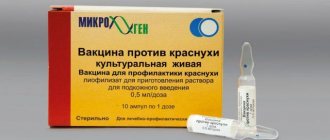Many consider rubella to be a mild childhood disease, and this is in vain: firstly, it sometimes causes serious complications, and secondly, it threatens the development of many pathologies in the newborn if his mother falls ill in the first trimester of pregnancy. In this article from the special project “Vaccination” we will tell you the history of the development of the rubella vaccine, describe the principle of its action and explain who and when should be vaccinated in order to avoid the tragic consequences of the disease.
Vaccination
The general partner of the special project is the Zimin Foundation.
The invention of vaccines has radically changed the life of mankind. Many diseases that claimed thousands, or even millions of lives every year, are now practically non-existent. In this special project, we not only talk about the history of vaccines, the general principles of their development and the role of vaccine prevention in modern healthcare (the first three articles are devoted to this), but we also talk in detail about each vaccine included in the National Vaccination Calendar, as well as vaccines against influenza and human papilloma virus. You will learn about what each of the pathogens is, what vaccine options exist and how they differ from each other, and we will touch on the topic of post-vaccination complications and the effectiveness of vaccines.
To maintain objectivity, we invited Alexander Solomonovich Apt, Doctor of Biological Sciences, Professor at Moscow State University, Head of the Laboratory of Immunogenetics at the Institute of Tuberculosis (Moscow), to become curators of the special project, as well as Susanna Mikhailovna Kharit, Doctor of Medical Sciences, Professor, Head of the Prevention Department of the Research Institute of Childhood Infections (St. Petersburg).
- Actually, this is a mild disease. You almost don't feel it. A rash appears, which is easy to hide with powder, you feel a little feverish, but nothing special. It seems like you feel pretty good, and you can leave the house and talk to people if you want. (...) And this is the key to everything, because rubella is an extremely contagious thing, you know? It doesn't cost anything to pick it up. But this disease has one peculiarity. If a woman gets it in the first four months...” Miss Marple said the next word with bashful good manners, “umm... pregnancy, the consequences are extremely serious. The child may be born blind or mentally retarded. Agatha Christie. The Mirror Cracked (1962)
Agatha Christie's novel The Mirror Cracked, the quote from which is given as an epigraph, is based on real events. In 1943, the famous American actress Gene Tierney (Fig. 1) contracted rubella during pregnancy. Her daughter, Antoinette Daria Cassini, was born prematurely, at just six months, weighed 1.42 kg, was deaf, partially blind due to cataracts and mentally retarded.
The emptiness inside me was like a cave,” Jean said. “She [Daria] was a sweet girl with golden curls and soft skin. Outwardly, she looked like any other child. I mourned Daria and mourned myself until I found out the cause of the misfortune.
Two years after the birth of her daughter, Jean found out who she contracted rubella from. At a tennis match, a woman approached her and, not knowing what tragedy her “heroic” act entailed, told her how she had sneaked out of quarantine and, sick with rubella, went to meet Jean.
“Everyone said that I shouldn’t go, but I just had to do it: you were my favorite!” — the fan said enthusiastically.
Stunned, Jean said nothing.
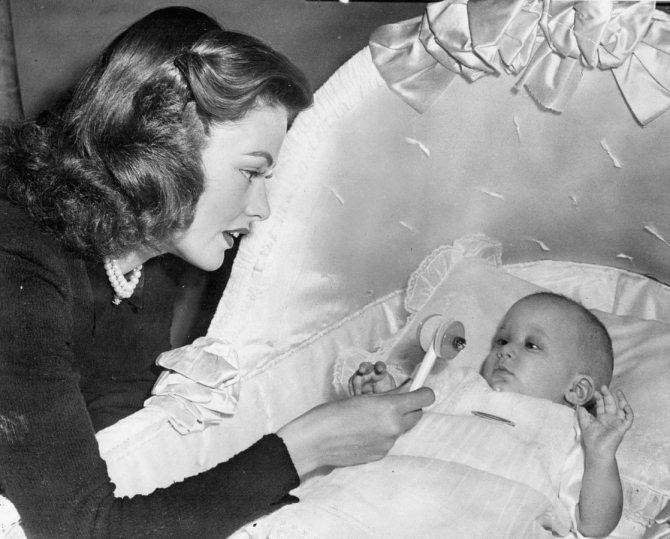
Figure 1. Gene Tierney with his daughter Daria.
With her daughter, Daria Cassini
Agatha Christie used this story as the beginning of a detective plot: the main character kills a fan who brought her so much grief. Nothing like this happened in real life, but the tragedy shook Jean's mental health. After the birth of Daria, the actress struggled with depression for a long time, including with the help of electroshock therapy. As a result of this treatment, Jean developed serious memory problems that interfered with her career. If not for that fateful meeting, the actress’s fate could have turned out completely differently.
Nevertheless, Gene Tierney made a significant contribution to American cinema and was nominated for an Oscar for Best Actress in the film God Be the Judge, released in 1945. And Daria spent her entire life in psychiatric hospitals, where she died in 2010.
Prevention of rubella in adults
Treatment for infection is nonspecific, so preventing infection is the best defense. Rubella is always bad for a pregnant woman, so it is necessary to take care of developing immunity in advance.
With vaccination, which uses a weakened virus, a mild form of the disease occurs, so there may be unpleasant reactions. Every fourth woman in the second week develops pain in small joints - arthralgia, there may be a slight enlargement of the lymph nodes and a rash. Formally, vaccination is contraindicated during pregnancy, but if the woman did not know about her status, then abortion after vaccination is far from necessary.
Gregg's children
Rubella is an insidious disease: it is easy to get infected, but sometimes difficult to reliably determine. It does not have such clear, unique symptoms as, for example, Filatov-Belsky-Koplik spots in measles [1]. Doctors for a long time could not describe rubella as a separate disease, confusing it with measles (hence its old name German measles - German measles) and scarlet fever, and for a long time they could not establish a connection between rubella suffered during pregnancy and serious damage to the fetus. A particular insidiousness of the disease is that it often affects the fetus in the early stages of its development - when the infected woman may not even suspect that she is pregnant.
Scientists realized that rubella had to be fought only in the middle of the 20th century, although they described it back in the middle of the 18th century. For two centuries, the disease received little attention and few discoveries were made about it (Fig. 2).

Figure 2. History of rubella research
drawing by Irina Efremova
The idea that rubella during pregnancy causes damage to the fetus was first formulated by Australian ophthalmologist Norman Gregg. This happened during the Second World War, which began for Australia in 1939. Most of the doctors were drafted into the army, but Gregg then specialized in children's vision and was one of the few ophthalmologists remaining in Sydney.
In 1941, Gregg observed an unprecedented number of cases of congenital cataracts—two to three times the normal rate. One day he heard mothers of such patients sharing with each other memories of rubella they had suffered early in pregnancy. Gregg then interviewed mothers of other children with congenital cataracts. It turned out that out of 78 respondents, 68 had rubella in the first trimester of pregnancy. In 1940, there was an outbreak of rubella in military camps, and soldiers returning to their families spread the infection.
Gregg theorized that rubella and congenital cataracts were related and published his hypothesis in 1941 [2]. He described other pathologies associated with rubella-associated congenital cataracts - today they are collectively known as congenital rubella syndrome. Gregg concluded that the fetus is more damaged when the mother has rubella early in pregnancy.
In Australia, Gregg's discovery was immediately accepted, but in the rest of the world it was treated with distrust, believing that Gregg did not have enough data to make such strong statements. This attitude changed after the American Conrad Wesselhoft published the article “Rubella and Congenital Deformities” in 1949, in which he provided statistics on lesions caused by rubella in more than 700 newborns [3].
There was no vaccine against rubella at that time, and the only reasonable method to stop the spread of the disease was quarantine. But it was not particularly effective, since sometimes the sick person himself did not know that he was contagious, but continued to lead a normal life, visiting public places and spreading the infection further and further.
Doctors began prescribing abortions for pregnant women with rubella. But the difficulty was that no one could accurately determine whether it was rubella or not: doctors focused only on the clinical manifestations of the disease (red rash, fever, redness of the throat), since the virus had not yet been studied or even isolated. The likelihood of error was high, and this caused a wave of criticism among opponents of abortion.
In parent circles, “rubella parties” were gaining popularity, which promoted contact between sick and healthy children (Fig. 3). It was assumed that thanks to this, all children would recover from rubella and receive lasting immunity. A rubella party could be a tea party in a poorly ventilated room, during which children drank from common dishes, played and kissed - in general, in every possible way increased the likelihood of infection and further spread of the infection.

drawing by Irina Efremova
Of course, such parties cannot replace vaccination. After all, if a child is not sick with rubella, it cannot be said that he is not sick with anything else - for example, the flu. It turns out that at such a gathering, children can exchange several diseases at once that threaten complications. This is especially dangerous for the main character of the event - a child with rubella: in order to avoid complications, he is generally advised to rest, and certainly not to have an additional infection.
What diagnostic methods are used in pregnant women?
After contact with a patient, a pregnant woman must be examined, determining the concentration of antiviral immunoglobulins M and G in the blood. This is done in the first 10 days; if immunoglobulin G (IgG) is found, then a conclusion is drawn about the presence of immunity and the woman is left alone.
In the absence of immunoglobulins, re-diagnosis is carried out after 10 days; if immunoglobulin M (IgM) is found, it is considered that the woman is already sick and the issue of terminating the pregnancy must be decided. Even in the second half of pregnancy, when the fetus is fully developed and may not develop defects, the likelihood of congenital rubella is high.
Take care of yourself, book a consultation now
Virus in an envelope
Back in 1914, Alfred Hess, based on experiments with monkeys, suggested the viral nature of rubella [4], which was confirmed in 1938 by Japanese scientists Hiro and Tosaka. They conducted an experiment that would be impossible to carry out in our time: a group of children were infected with rubella using swabs from the nasal cavities of patients with acute signs of infection.
Rubella virus (Rubella virus) represents the genus Rubivirus, which until April 2021 was classified together with the genus Alphavirus in the family of togaviruses (from Latin toga - bedspread). However, there is enough evidence to separate rubiviruses into a separate family, Matonaviridae, named after Georg de Maton, who first distinguished rubella from measles and scarlet fever. Some alphaviruses cause arthritis and encephalitis in humans and are usually transmitted by arthropods. The rubella virus does not require a vector and is very different from alphaviruses at the molecular level, and in severe cases it can also cause arthritis and encephalitis.
The structure of the rubella virus resembles the fairy-tale description “in the chest is a hare, in a hare is a duck, in a duck is an egg, in an egg is a needle, the death of Koshchei” (Fig. 4). All genetic information of the virus is stored in single-stranded linear RNA and, like Koshcheev’s death, is enclosed in a case - an icosahedral capsid with a diameter of 40 nm (an icosahedron is a regular polyhedron with 20 faces and 12 vertices). The capsid is surrounded by a lipid membrane, often called the viral envelope in English literature. This envelope is a fragment of the host cell membrane [5] and helps the virus pass by the immune system undetected. Spikes consisting of viral proteins E1 and E2 protrude above the surface of the membrane. The first protein is necessary for the virus to attach to the host cell and draw the virion inside, while it also serves as the main target of the immune response and the production of virus-specific antibodies.
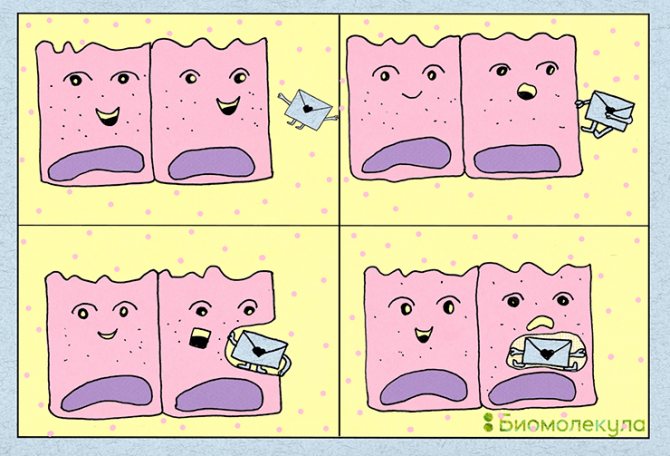
drawing by Irina Efremova
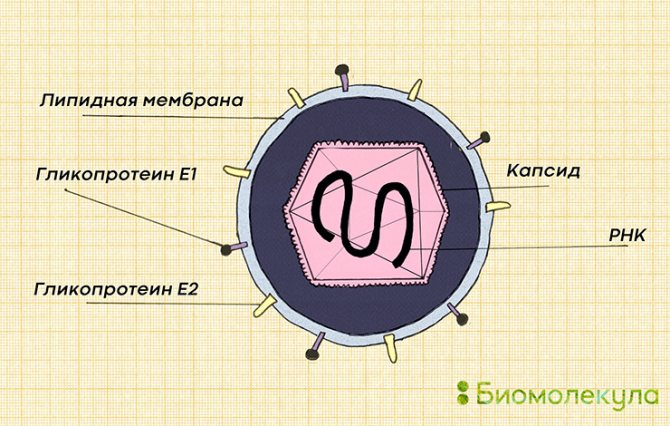
Figure 5a. Schematic representation of the rubella virus
drawing by Irina Efremova
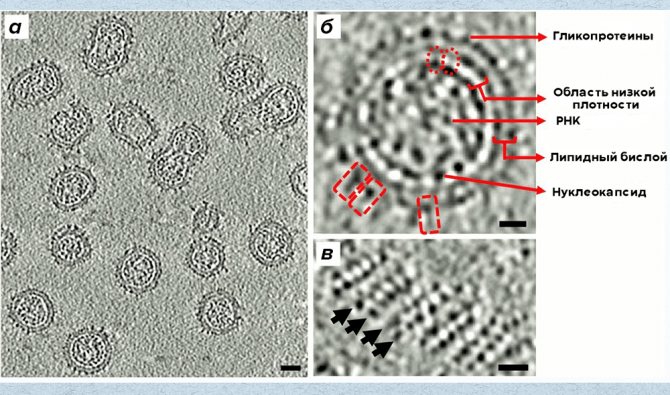
[27]
Differences in the amino acid sequences of E1 proteins made it possible to identify two genetic groups of the rubella virus [6]. These groups, which differ in E1 by 8–10%, are in turn divided into 13 genotypes, each of which is assigned an Arabic number and a Latin letter. Each genotype has unique chronological and geographic characteristics. For example, genotype 1a was distributed worldwide in the 1960s and 70s and almost disappeared after 1980; in the period from 1995 to 2005, genotype 1E “walked” across Canada, and 2c - across Russia (Fig. 6).

Figure 6. Distribution of rubella virus genotypes by country, 1995–2005
[6]
The distribution of genotypes gives grounds for thought: the same genotype can spread over territories distant from each other. Thus, 1E could be found in Africa, the Americas, Asia and Europe, and 1G - in Côte d'Ivoire, Belarus and Uganda (who would have thought that these three countries had something epidemiologically in common?!).
Is it true that the disease is mild?
For adults, infection is not always easy; for every patient, there are two people who have had an asymptomatic infection or a very mild one, which was mistaken for a common cold. For an organism burdened with chronic diseases, in principle, any infection is dangerous, and the rubella virus also causes intense clinical manifestations that can hardly be called mild. There is a high temperature, a severe rash, and prolonged enlargement of the lymph nodes, as well as completely nonspecific pain in the muscles and joints.
Rubella is more than just a rash
Rubella is transmitted by airborne droplets. Newborn children rarely get sick [7], since they are temporarily protected by maternal antibodies if the mother was sick or was vaccinated against rubella. The disease spreads mainly in close-knit groups - most often among schoolchildren.
The reproduction (replication) of the rubella virus takes from 8 to 12 hours. During this time, the virus penetrates the cell and modulates its biosynthetic apparatus, with the help of which it produces its “descendants”. This slow (for a virus) replication results in a long latent period of infection, lasting from 15 to 24 days. At this time, the infected person does not have any external signs of the disease, however, the virus is already multiplying in him, and the person becomes infectious one to two weeks before the rash appears. A person can be considered fully recovered and non-infectious one to two weeks after the rash disappears [8].
The clinical picture of rubella is characterized by nonspecific symptoms such as headache, fever, pharyngitis, conjunctivitis, and enlarged occipital and posterior cervical lymph nodes. In children, the temperature usually does not rise above 39 °C. About 48 hours after the onset of the disease, red, non-itchy spots appear on the skin. The rash predominates on the face, lower back, buttocks, and bends of the limbs (Fig. 7) and lasts 2–4, occasionally 5–7 days, then disappearing without pigmentation or peeling. The patient is most contagious in the first five days after the rash appears [9]. Asymptomatic forms of the disease also occur: a person does not even suspect that he is working as a viral incubator, and therefore does not take any measures to prevent infection of others.
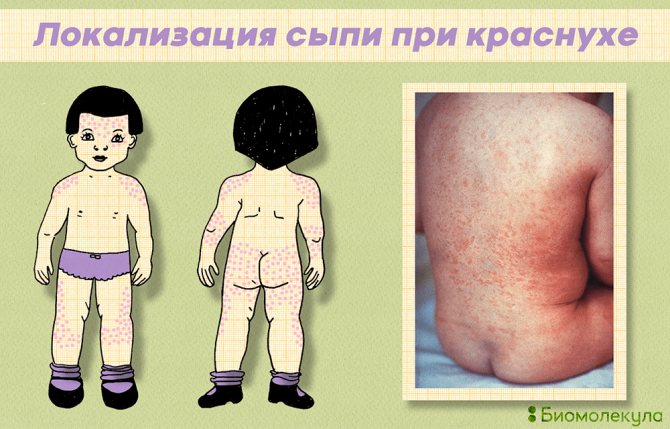
drawing by Irina Efremova, photo - Wikipedia
Complications occur rarely and mainly in those who do not follow the doctor’s recommendations or have significant problems with the immune system. The most dangerous of the complications is rubella encephalitis (inflammation of the brain), which occurs with a frequency of one case per 5,000–6,000 cases. The virus can be found in the cerebrospinal fluid and central nervous system. Quite often, up to 70% of cases, women develop arthritis. For men and children, this is a rare complication [10].
How can you become infected with rubella?
How rubella manifests itself is clear from the name - red skin from a profuse rash, but there are other symptoms. Rubella is caused by a tiny virus, similar to a soccer ball, with RNA twisted inside it. It can fly around a room alive for several hours; it does not like ultraviolet radiation from sunlight or heat, but when alive it can withstand frost.
The pathogen is evil, but not as aggressive as measles and chickenpox, which are practically transmitted without contact. The cause of rubella is fairly close contact with a patient with an obvious or hidden infection; transmission occurs when a microscopic drop of saliva infected with the pathogen is inhaled or gets on the skin.
It is assumed that in childhood the infection can be caused by licking a sick child's toy, but in adults there is no such contact method of transmission. It’s strange, because adults can kiss, however, for serious adults, only one cause of the disease is indicated - airborne infection with an aerosol of saliva.
The Medica24 international clinic uses high-precision equipment to conduct round-the-clock examinations, which allows you to quickly make a correct diagnosis and begin treatment without delay, and this is possible on holidays and weekends.
We will call you back
leave your phone number
Effect on the fetus: numbers and facts
Let us recall the case described at the beginning of the article: due to her mother’s illness, Daria Cassini was born with cataracts, deafness and mental retardation - these developmental defects are now called congenital rubella syndrome (CRS) . In 75% of cases, CRS manifests itself as a combination of two or more developmental pathologies [11].
Rubella occupies an important place in the list of medical recommendations for abortion. Of course, no one can force a woman to have an abortion; the final decision is always hers. The exact wording is as follows: “Interruption of pregnancy up to 12 weeks, incl. in contact with patients with rubella in the absence of immunity in a pregnant woman.” It is in the early stages that the virus affects the embryo the most. CRS then serves as a platform for the development of delayed pathologies - diabetes, thyroiditis , and in one case out of 100,000 - panencephalitis.
Manifestations of CRS in newborns depend on what week of pregnancy the mother had rubella [11–13]. This is due to the fact that the organs and tissues of the fetus are formed gradually, and the virus prevents their normal development. Thus, damage to the hearing organs was observed in newborns whose mothers suffered from rubella during the 2nd–4th month of pregnancy, disorders of the formation of the brain, heart and organs of vision - from the first weeks to the end of the 3rd month, retinitis pigmentosa (retinal damage) and deafness - in beginning of the second trimester of pregnancy (Fig. 8).

drawing by Irina Efremova based on [12]
As we have already mentioned, the earlier during pregnancy a woman experiences rubella, the higher the likelihood of having a child with CRS. The virus damages the fetus most severely in the first trimester of pregnancy.
In 1978, an outbreak of rubella occurred in England, which allowed scientists to observe a large number of newborns whose mothers were ill at different stages of pregnancy. The observation results were published in The Lancet in 1982 [13]. Of the 1,016 women who had rubella, 523 had an abortion for medical reasons, and 36 had a miscarriage. Children with CRS were born to 80% of mothers who became ill at 1–12 weeks of pregnancy, to 54% at 13–14 weeks, and to 25% at the end of the second trimester. All (!) observed mothers who had rubella before the 11th week had children born with serious developmental disorders (most often with heart defects and deafness). After the 16th week of pregnancy, the risk of damage decreased significantly, gradually tending to zero: among the children who encountered the virus during this period, the authors of the article counted 63 healthy ones.
The mechanisms of the teratogenic effect of the virus have not been studied in detail, primarily because it is impossible to find a model animal suitable for reproducing all stages of the disease. It is assumed that the virus acts in two directions: restraining the division of fetal cells and inducing their death through the mechanism of apoptosis (programmed cell death) [14]. Thus, the virus prevents the organs and tissues of the embryo from developing properly. Hence the dependence of fetal damage on the moment of its infection with rubella (Fig. 8): organs and tissues that are at the stage of formation are most affected.
What manifestations of rubella occur in pregnant women?
Pregnant women do not have any special symptoms of rubella, and they require treatment exactly as much as it helps all other adults. It can also occur easily and even unnoticed, but the virus penetrates through the general bloodstream into the pregnant uterus, where it damages the inner lining of the blood vessels, disrupting the blood supply to the fetus. The virus inserts itself into the DNA and changes the division of fetal cells, as a result of which it develops with defects. The greatest damage is caused to organs and systems developing during viremia, especially in the first weeks of pregnancy. The probability of congenital pathology is close to 100%.
Creation of a vaccine
In the first half of the 1960s, the rubella pandemic broke out in Europe [15]. In the United States alone, 12.5 million cases of this disease were recorded in 1964–1965. 50,000 pregnant women suffered from rubella, which led to 11,000 miscarriages and 20,000 children born with CRS. Of these, 2,000 were deaf, 3,580 were blind, 1,800 were mentally retarded. It was then that the need to accelerate the development of a vaccine became urgent (Fig. 9).
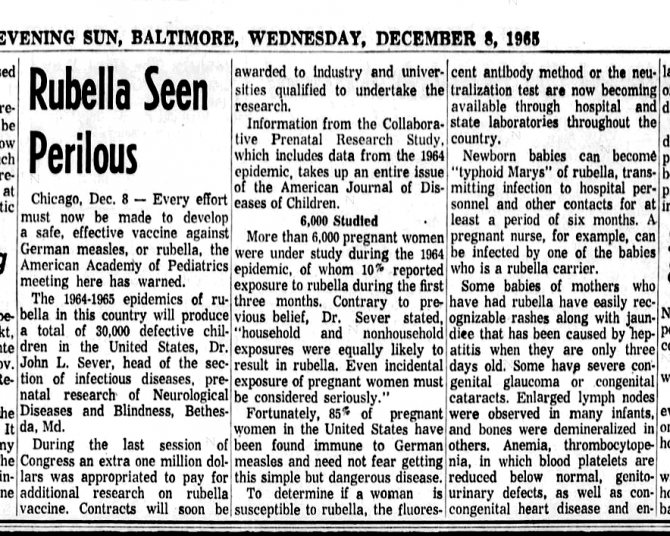
Vaxopedia
In 1962, the rubella virus was independently isolated by two groups of American scientists: Paul Parkman's team (Fig. 10) infected a culture of African green monkey kidney cells with it, and Thomas Weller's group infected human amnion cells. Thus, it was possible to show that the rubella virus can be maintained in a wide variety of cell cultures, which is very convenient for creating a vaccine.
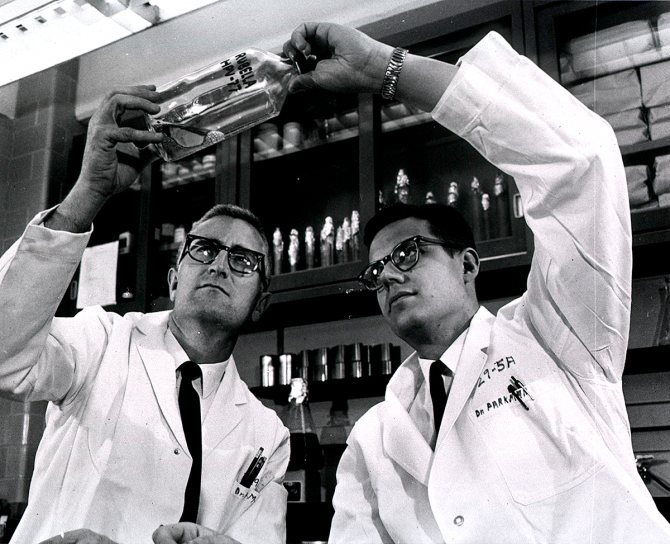
Figure 10. Rubella vaccine developers Paul Parkman and Harry Meyer.
Developers of a promising new experimental vaccine against rubella (German measles)
In 1966, Parkman developed the first live attenuated vaccine, HPV-77 [16], and immediately tested it on children whose parents signed consent to participate in clinical trials. There were 8 participants each in the control and experimental groups. None of those vaccinated with rubella got sick or experienced any side effects from the vaccine.
Nowadays, any medical drug must undergo clinical trials before ending up on pharmacy shelves and in the doctor's office. But it was not always so. The practice of clinical research in its modern form was finally established in 1996, but long before that, “experimental subjects” signed consent to participate in such experiments. The article “One by one with the world: how the components of a clinical trial came together” tells more about the birth of this practice [17]. - Ed.
The entire vaccine kitchen has already been described in the article “Development of vaccines: how and with what to imitate a disease?” [18]. Here we just remind the reader that an attenuated vaccine is a drug prepared from “harmless” pathogens that have lost the ability to cause disease. Such agents multiply in the body (which is why the vaccine is called live), cause an immune response, as in a real infection, but are too frail to develop the symptom complex of the disease. Viruses become harmless in the process of adaptation to hosts that are not typical for them, which are most often the embryos of chickens, ducks, quails or cultures of cells isolated from the body a long time ago and capable of growing and dividing in a nutrient medium. Thus, Parkman subcultured the rubella virus 77 times in a culture of green monkey kidney cells (hence the number 77 in the name of the vaccine), which significantly weakened the virus.
In 1969–1970, three more rubella vaccines were registered in the United States [19]. After transplanting HPV-77 five more times into duck embryo fibroblasts, Parkman received the HPV77DE5 (DE - duck embryo, 5 - number of passages). HPV77DK12 vaccine was obtained by passages of the virus in a dog kidney cell culture (DK - dog kidney), and Cendehill - in a rabbit kidney cell culture. However, all of these vaccines were imperfect: they caused an insufficient immune response, but could provoke serious adverse reactions, the most common of which was arthritis in women. In 1979, they were replaced by Stanley Plotkin's live attenuated vaccine - RA 27/3 (video 1). The immune response to it was close to that caused by the “real” rubella virus, and the titer of specific antibodies in the blood was higher than with other vaccines.
Video 1. Stanley Plotkin talks about the development of the rubella vaccine.
Plotkin and rubella epidemic
The Plotkin vaccine has become the basis of rubella vaccination programs in most developed countries [20]. Thanks to her, SVK won in North and South America. It is noteworthy that the vaccine, which protects children around the world from congenital deformities and prevents erroneous abortions, was created on the basis of material from two aborted human embryos. The virus was obtained from the cells of a fetus infected with rubella. His mother fell ill around the third week of pregnancy, and the abortion was performed 17 days later. The viral strain was named RA27/3 (R - rubella, A - abortion, 27 - number of the aborted fetus, 3 - number of the tissue sample).
In 1964, Leonard Hayflick obtained an excellent cell line suitable for cultivating all kinds of viruses from the pulmonary fibroblasts of an aborted 12-week embryo. The pregnancy was not terminated for medical reasons; the fetus developed normally. The line was named WI-38 - in honor of the Wistar Institute , where it was received. It was this cell line that Stanley Plotkin chose to tame his rubivirus. Later, when asked whether the use of human cells in the production of vaccines could cause disease transmission, Plotkin replied: “The embryo [used by Hayflick] was chosen by Sven Hard specifically for the creation of a vaccine. Both parents are known to us, they are still alive and live in Stockholm. They decided to have an abortion because, in their opinion, they already had too many children. In the biography of neither of the parents there is information about family diseases and, most importantly, there is no information that anyone in their family had cancer.”
Leonard Hayflick discovered that normal cells in cell culture are not capable of dividing indefinitely, but have a division limit called the Hayflick limit. During his research, Hayflick also discovered that when specially stored in a freezer, some cells not only survive, but also retain the ability to divide for much longer. One of these lines was WI-38, isolated by Hayflick. It turned out that it does not contain viruses (unlike the monkey kidney cell line used to produce vaccines previously) and withstands freezing/thawing well. Thanks to this latter characteristic, WI-38 is used not only for vaccine production, but also in numerous cell biology studies. - Ed.
Observing a low-temperature regime, Plotkin passaged the rubella virus in WI-38 25 times. As a result, the virus lost its ability to cause disease, but was still immunogenic [21].
To Plotkin’s comment, I would like to add that the cell line serves only to reproduce and weaken the virus and is not part of the vaccine. At the same time, let’s comment on one of the “horror stories” that can be heard from those who oppose vaccinations. The production of vaccines does not require more and more abortions : the cells used are capable of dividing almost endlessly.
How does the infection enter the body?
The reason for the introduction of an infectious agent is its entry into an environment favorable to it, where the program laid down by nature forces it to multiply. Once on the moist and warm mucous membrane of the nose or mouth, tiny pores are formed in the virus shell, through which the RNA is introduced into human cells suitable for further life. The particle has a special predilection for epithelium and lymphatic tissue.
Having entered the blood through an epithelial cell, the pathogen migrates to the lymph nodes, where it temporarily takes root to reproduce and accumulate its own army, therefore one of the first manifestations of rubella is enlarged lymph nodes. The cause of the appearance of the red rash, which gives the name of the disease and the most striking symptom, is the travel of multiplied viral particles throughout the body with accumulation in the skin. Having settled in the skin, the pathogen gradually dies.
The infectious diseases specialist at the international clinic Medica24, having a broad clinical horizon, has at his disposal the most modern diagnostic equipment with the ability to perform complex tissue tests, which affects the patient’s favorable prognosis.
Global vaccination
The Stanley Plotkin vaccine has been used all over the world for more than 40 years. By the end of 2013, mandatory vaccination against rubella was introduced in 137 countries, and by the end of 2021 - in 152 out of 192 countries. Vaccination rates range from 13 to 99%. The number of identified cases of rubella has decreased by 97% over the past 15 years, from 670,894 in 102 countries in 2000 to 22,361 in 165 countries in 2016. Most children with CRS are born in Africa and Southeast Asia, as vaccination rates are lowest there.
On February 6, 2021, the World Health Organization officially announced that rubella was defeated in Russia: in 2018, as in 2017, only five cases of rubella were recorded, and it was not possible to identify newborns with CRS (Fig. 11). This was achieved through routine vaccination, which has been taking place in Russia since 2007 and now covers 97% of children and women under 25 years of age (see section “When to get vaccinated?”). As we already wrote in the article “Measles: the war against the childhood plague continues” [1], the vaccine protects not only the person being vaccinated, but also those who for some reason were left without vaccination - for example, due to medical contraindications. The idea is simple: the more people receive the vaccine, the fewer people in the population will get sick and the fewer spreaders of infection there will be.
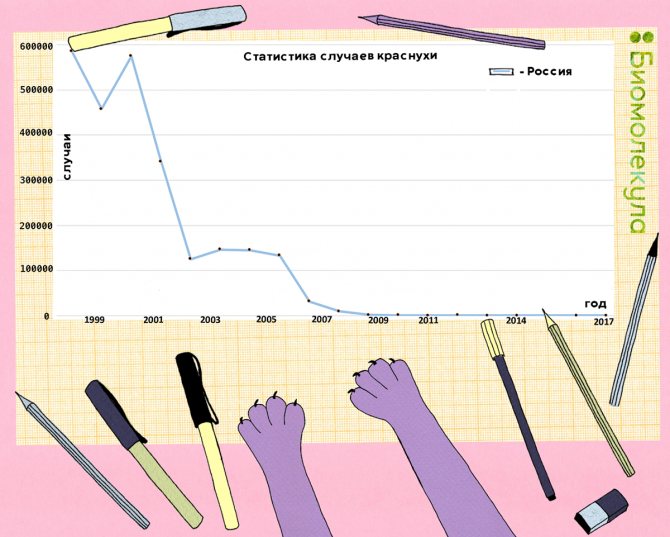
drawing by Irina Efremova according to WHO data
Why is vaccination against rubella necessary if Russia is declared a rubella-free country by WHO?
Answered by pediatrician Sergei Butriy.
And then that in other countries there is a lot of rubella, and Russia has many neighboring countries that the WHO has not declared free from rubella. For example, the United States has long been a country free of rubella, but no one is thinking of removing this vaccination from the list of mandatory ones.
Moreover, if we refuse now, after the elimination of the rubella virus, from planned immunization programs, then after some time, when collective immunity weakens, if the virus is brought into the country, a paradoxical increase in cases of congenital rubella syndrome may occur - this is, in particular, the position of the WHO :
“Persistently low coverage of rubella vaccination among infants and young children (for example, when rubella vaccination is provided only by the private sector) may lead to increased susceptibility among women of childbearing age, which may increase the risk of an increase in the incidence of congenital rubella syndrome above pre-existing levels. introduction of the vaccine (the so-called paradoxical effect). However, if vaccination coverage is high enough, transmission of the virus will be markedly reduced or interrupted, thereby eliminating the risk of exposure of pregnant women to infection” [22].
Therefore, one should treat the WHO’s statement about the liberation of Russia from rubella with restrained joy: it is good that we have finally received this status, but an important battle has been won, not a war, and it is too early to relax.
Features of rubella symptoms in adults
All infections that must be overcome in childhood are more severe in adults.
- Symptoms during the catarrhal period are more pronounced than in children.
- The temperature is higher and the signs of intoxication are more intense.
- Enlarged lymph nodes in adults are less common and develop more slowly.
- The duration of the catarrhal period is longer; children usually cope within a day.
- The rash is more abundant and does not disappear in children.
However, for every adult patient with severe manifestations of rubella, there are two patients in whom all symptoms went unnoticed, and the disease was discovered only through a special diagnosis of antibody levels.
The international clinic Medica24 has everything you need for effective treatment and effective recovery; all programs are individualized and based on world standards of diagnosis and treatment. Specialists from the Center for Infectious Diseases are ready to help, call
The World Health Organization is confident that rubella will not last forever for humanity, so at the end of the last century it set the task of reducing the incidence to a minimum value, and the congenital infection should not affect more than one baby out of 100 thousand newborns.
When to vaccinate?
According to the National Vaccination Schedule and WHO recommendations, the combined vaccine against rubella and measles is administered to children twice: at the age of 1 year and 6 years . Repeated vaccination is carried out because antibodies against measles are not produced in approximately 15% of children vaccinated at one year of age [23]. The second vaccination provides reliable protection for almost all children before starting school.
All adolescents under 18 years of age (not previously vaccinated or vaccinated once) and girls from 18 to 25 years of age are vaccinated once: the rubella vaccine provides immunity in 95% of cases for a period of about 10–20 years. Therefore, if you have been vaccinated a long time ago, the only way to check whether you are protected from rubella is to measure the level of relevant antibodies in your blood. This is recommended for women planning pregnancy. If there are no antibodies, you need to get vaccinated and then postpone conceiving a child for at least two months. This expectation is due to the fact that the vaccine is, although defective, a live virus and theoretically can harm the fetus (for more details, see the section “Contraindications and side effects”).
Who needs a special diagnosis for rubella?
The danger is not in the disease itself, it is quite mild, but in pregnant women it leads to miscarriages, forms deformities in the fetus, and is transmitted through the general bloodstream to the unborn child with the formation of congenital rubella syndrome.
All young women need diagnostic screening, which detects the presence of antibodies to the rubella virus in the blood. Diagnosis is possible in several ways. If antibodies are detected, it means there is immunity. If antibodies are not found, then preventive vaccination is indicated.
The most modern diagnostic equipment of the international clinic Medica24 allows in a short time to conduct an in-depth examination and find out the cause of the disease, and, based on error-free information, create an individual therapeutic strategy.
What vaccines are available in Russia?
The vaccine used in Russia is the same RA27/3, which was discussed above.
At the time of writing this article, it is available in the Russian Federation only in the form of a single vaccine, but in 2021 it is planned to release combined vaccines - against measles and rubella (MR) and against measles, mumps and rubella (MMR) (Table 1). Table 1. Rubella vaccines available in Russia. At the time of writing, rubella vaccination could be done with a mono-vaccine produced by Microgen and MMR II (M-M-P II).
| Vaccine name | Manufacturer |
| Cultured live rubella vaccine (monovaccine) | JSC NPO Microgen, Russia |
| Vaktrivir (live combination attenuated vaccine against measles, mumps and rubella) [24] | JSC NPO Microgen, Russia |
| MMR II (live combination attenuated measles, mumps and rubella vaccine) | Merk (country of origin varies) |
What complications of rubella can occur during pregnancy?
The disease in a pregnant woman is no different from other adults, but the gestating fetus has poor prospects.
- Miscarriages occur in every third case, every fifth is stillborn, every fourth newborn dies.
- In the first trimester, the infection penetrates the fetus in 8 cases, in the second and third trimesters - in 3-5 out of ten.
- Infection of a 9-12 week fetus guarantees that every third newborn will have malformations; up to 20 weeks, deformities are observed in every tenth.
- Every tenth newborn with developmental anomalies is caused by the rubella virus.
- Congenital infection syndrome is guaranteed 60% when the mother is infected at 3-4 weeks of pregnancy, by 12 weeks the frequency decreases to 15%, by 14 weeks - to 7%.
Contraindications and side effects
The rubella vaccine, like any other, has contraindications. It should not be administered to people with severe allergic reactions (such as anaphylaxis) to aminoglycosides. If such reactions have already occurred, you should definitely notify your doctor about this. Other contraindications include taking immunosuppressants, radiation therapy and severe immunodeficiencies (for example, AIDS). The live vaccine is not administered to pregnant women, but if they are vaccinated against rubella by accident, this does not become a reason to terminate the pregnancy [25]. Scientists have managed to collect some good statistics on this matter. Almost 50 million women of childbearing age were vaccinated in Latin America between 2001 and 2008. Of these, almost 30,000 were either pregnant or became pregnant within a month of vaccination. Not a single case of CRS was found in their children [25].
Side effects of the rubella vaccine have been rarely observed. In America, more than 250 million adolescents and adults have been vaccinated, and no serious adverse reactions associated with this vaccine have been identified [26].
Often, after vaccination, local reactions occur that have nothing to do with “complications” and do not require special treatment: for example, swelling at the injection site (10% of cases) or rash (5%). It is also possible to increase body temperature to 38 °C (5–15% of cases).
After administration of the mixed MMR vaccine (measles, rubella, mumps), 1 in 300,000 vaccine recipients developed thrombocytopenia (see article on measles [1]). After suffering from rubella, this condition occurs in 1 in 300 cases.
Sometimes encephalitis is indicated as a “complication” of MMR vaccination, the frequency of which does not exceed 1 in 1 million vaccinated people, but there is no direct evidence of such a connection (see the article “Measles: the fight against childhood plague continues” [1]).
What signs are characteristic of the onset of rubella in adults?
The incubation period from the entry of the virus to the appearance of the first symptoms of infection lasts on average about three weeks, but can be 10 days and four weeks. The first signs of rubella in adults are quite pronounced: increased body temperature and catarrhal symptoms, like a cold.
In adults weakened by chronic diseases or with reduced immunity, the temperature may be high, muscles ache and a headache. Most adults have a sore and sore throat, watery eyes, and strong irritation from bright light.
The difference from a cold is an enlargement of the lymph nodes, mainly on the back of the head and back of the neck; regardless of treatment, this symptom of rubella lingers for almost 3 weeks, while the entire catarrhal period lasts no more than three days.
A specialist with extensive clinical experience needs modern equipment and the ability to perform complex tests; only in such conditions can an accurate diagnosis be made. All this is available at the Medica24 international clinic, you can verify this personally, we work seven days a week and seven days a week. Make an appointment by phone: +7 (495) 230-00-01.
What will you choose - a vaccine or a disease?
As we wrote above, if you follow the vaccination rules, the risk of complications after administering the rubella vaccine is very low. Disease is another matter: the most severe complication of rubella - encephalitis - occurs in one in 5-6 thousand. If we use statistics from 2000 for Russia, we get 80 people with this complication. Quite a lot, you must agree! And let's not forget about the possible infection of a pregnant woman, which can lead to serious defects in the development of the fetus. Therefore, vaccination is the best solution today.
When is a patient most dangerous to others?
The release of an infectious agent into the external environment begins when neither the carrier himself nor those around him even suspect infection. A seemingly healthy person, but already filled with pathogens inside, throws out infected saliva a week before the rash develops.
And after the rash appears, when everyone is already shying away from it as a possible cause of future health troubles, it also releases infectious agents, for a total of at least two weeks the patient is dangerous for healthy and unvaccinated people. Children born with congenital rubella can cause infection in adults from a year to a year and a half, during which time the infectious agent lives in their saliva and secretions.






